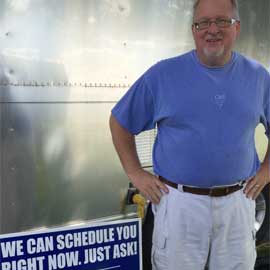
PROPER CARE & TANK MAINTENANCE
HOW DO YOU CLEAN AND DEODORIZE YOUR RV TANKS?
If there’s one topic that is common to every RVer, it’s holding tanks! In fact, next to the oh-so-common frustration about tank sensors and the always-reliable question about the best tank additive, the next most frequent question we get is about how to clean RV holding tanks. So let’s take a look at the topic.
Different kinds of RV holding tanks
There are three main types of RV holding tanks. Most RVers know this, but let’s take a quick look at all three.
Freshwater holding tank. Almost all RVs have one of these. They are the biggest of the three tanks (in motor coaches, they’re pretty close to the combined capacity of the single black and gray tanks!) and hold your potable (or drinkable) water supply.
Black water holding tank(s). These tanks hold the waste from your RV’s toilet and, sometimes, bathroom sink. Some RVs, especially fifth wheels, may have a black tank that collects waste from a half bathroom as well as a clothes washer. These are called “combo” or combination tanks. Most RVs have just one black water holding tank, but we’ve seen as many as three in larger fifth-wheel RVs.
Gray water holding tank(s). These tanks collect waste from the RV’s shower and bathroom sink as well as the galley or kitchen sink. Some RVs have one gray tank for the shower and bathroom sink and a separate one for the galley. Most RVs have one or two gray tanks, though we’ve seen as many as three or even four on larger RVs.
Cleaning and deodorizing freshwater holding tanks
Freshwater tanks should be sanitized (cleaned) with great frequency, at least twice a year (for most seasonal and occasional RVers) to as many as four times (or more) a year for full-time RVers. When you sanitize your freshwater tank, you will also be sanitizing your RV’s entire water supply plumbing system.
We’ve covered the exact how-to on freshwater tank sanitation elsewhere, but the quick rundown is to introduce a sanitizing solution of either bleach or vinegar into the holding tank, circulate it through the plumbing supply, let it sit for a while to sanitize, and then flush it out.
Cleaning black and gray holding tanks
First, there’s no substitute for having your RV’s black and gray holding tanks cleaned annually or (if you’re a full-time RVer, heavy use RVer, or your RV has tank problems), twice a year. Much like an annual tune-up on a driving vehicle, regular professional tank cleanings can help you to avert any serious and costly problems down the road.
As for cleaning these tanks yourself, here are some tips you should implement into your RVing experience:
Use plenty of water. Believe it or not, this is the most important thing you can do to keep your RV’s waste holding tanks clean. Following the two-flush method with the toilet, traveling with water in your holding tanks, and priming the tanks with water before you use them are all smart steps.
Empty your tanks when they’re full. A full holding tank is one that will clean itself out the best. Add water to the tanks to raise their volume to 75% to 100% before emptying them. The added weight and volume of the water will help ensure a “cleaning flush.”
Turn on those tank sprayers. Most RVers use their tank spray systems to rinse out their tanks after emptying, but it’s also smart to turn them on while you are emptying the tanks. That added water and turbulence will help waste to move out quicker and more thoroughly.
Rinse, rinse, rinse. After you’ve emptied your black and gray holding tanks, either use the onboard tank sprayers, water down your toilet and sinks, or a device like the Valterra Flush King Reverse Flush Valve to clean and rinse the tanks.
Keeping waste tanks clean
We’ve talked about the importance of using plenty of water in your tanks and, really, that’s all you need to do to keep them healthy and performing optimally. Most RVers use a tank additive in their waste holding tanks and we can’t recommend our Calgon-PineSol mixture enough. Those other tank additives that dissolve, break down, and cause waste to become a thick, sticky paste? Not so much.
Cleaning vs. deodorizing
Some RV owners ask us about deodorizing their holding tanks. Really, in the freshwater tank, frequent sanitation and use will take care of odors from molds and mildews. In waste holding tanks, smart cleaning and use strategies combined with the deodorizing and cleaning functions of our Calgon-PineSol mixture will eliminate almost every odor in your holding tanks.

Jim Tome, Owner
Hi, I'm Jim Tome and, along with my wife, Debbie, the owners of Kleen Tank LLC, the national leader in RV holding tank cleaning service. We've been RVers like you since 2004 and have traveled all over the U.S. in our Airstream travel trailer. We started the business about twelve years ago and have cleaned tens of thousands holding tanks in thousands of RVs. From tiny weekend travel trailers to monstrous fifth wheels to luxurious motorhomes, I've seen just about every situation there is with RV holding tanks and waste systems. I hope you enjoy our articles; I try to post at least one per week and we've got a great library of them to cover just about every problem. Enjoy!
Keep in mind that we may receive commissions when you click our links and make purchases. However, this does not impact our reviews and comparisons. We try our best to keep things fair and balanced, in order to help you make the best choice for you.
MAKE A QUICK INQUIRY
WE'LL GET RIGHT BACK TO YOU
WE'RE HERE FOR YOU
CONNECT WITH US
844-KLEENME (844-553-3663)
info@KleenTank.com
Facebook.com/KleenTank
Instagram.com/KleenTank
WHAT DOES OUR SERVICE DO?
IT'S PRETTY SIMPLE...
Fixes and corrects your RV's tank sensors almost every time.
Features innovative, hydrojetting technology.
Is a 100% mobile service. We come to you at your site.
Is environmentally safe and makes no mess at your site.
Is chemical-free and all-natural.

0 Comments